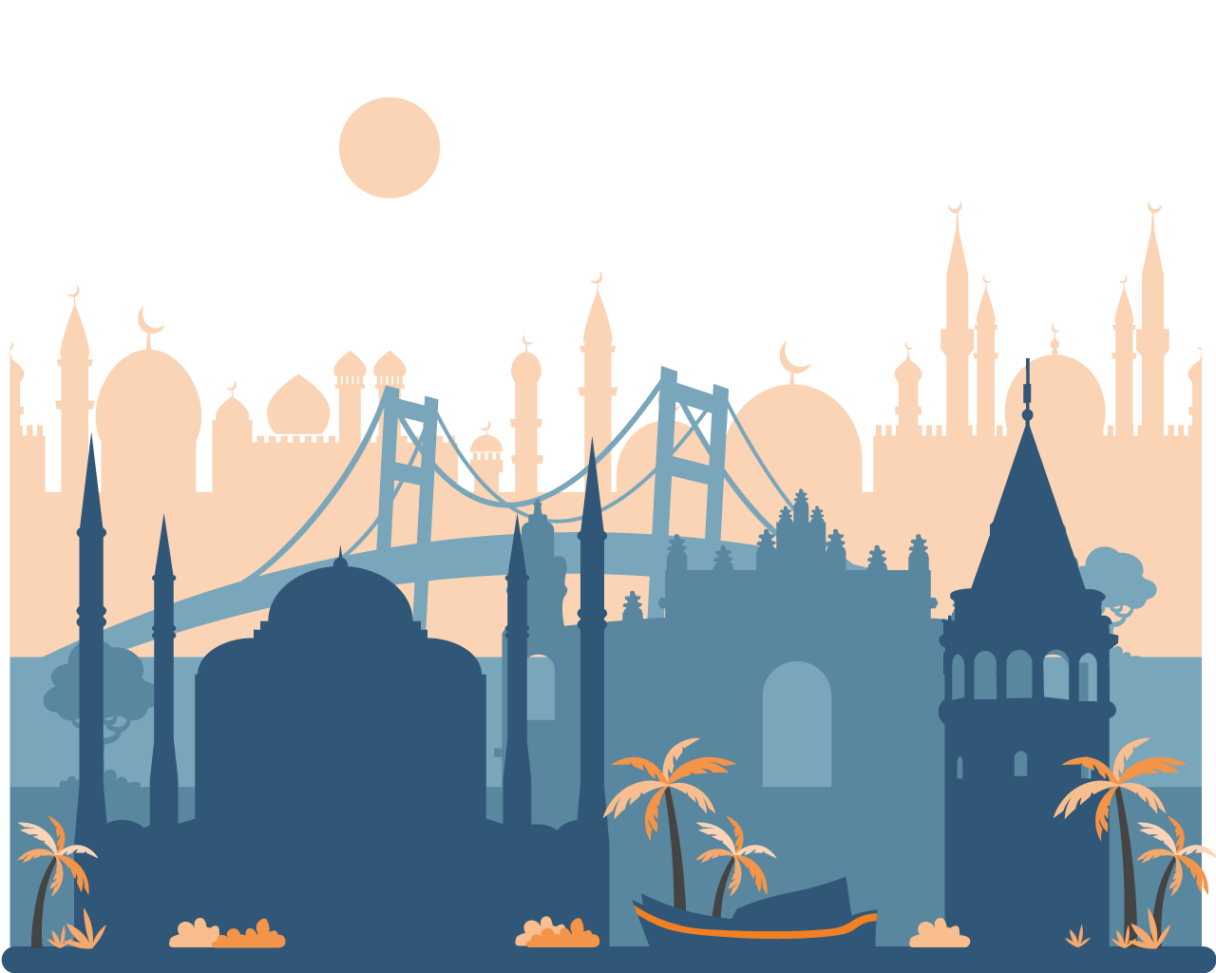
Erasmus Courses for Teachers in Istanbul, Turkey
OID: E10166501
The city that straddles two continents, boasting stunning mosques, delicious cuisine, and a prestigious education system.
Confirmed Sessions in Istanbul
About the Training Centre in Istanbul
All our teacher training courses in Istanbul will take place either in the Morning (9.00-13.45) or in the Afternoon (14.00-18.45) depending on classroom and trainer availability.
Our training center is located in the heart of the city, right next to Istiklal Street. This historical avenue, which connects Taksim Square and Tünel Square, is filled with shops, restaurants, cafes, art galleries, cinemas, theatres, and libraries. Follow the variety of architectural styles in Istiklal Street and explore the history of the city.
How to reach us:
The training center “Academy Beyoğlu” is easily accessible, just a 6-min walk from Taksim metro station via Istiklal Street.
Our address: str İmam Adnan 9, 34435 Beyoğlu, İstanbul
Organization’s Fiscal Data
OID: E10348110
Company name: Rodopoulou Chrysanthi E.E.
Trade name: Iconic Productions
Activity: Media Production Services
Address: Sabbagh Khoury 3, 15125, Athens, Greece
VAT: EL801816732
Responsible Person (name, function, e-mail, tel):
Dr. Ambra Falabella, Director of Europass SRL Office and Courses Operations
Email: teacheracademy@europassnetwork.eu
Phone: +39 055 1997 3220
Public transport in Istanbul:
Tickets can be easily bought at public transportation stations, but you may also purchase the IstanbulKart (a physical transportation card) and top-up your card according to your needs. The card is versatile and useful as it is valid for all types of public transportation in Istanbul (metro, tram, Metrobus even ferries).
Our Cultural Activities
The following cultural activity is included in the price of each Erasmus course in Turkey:
- Free access to one museum
- A half-day Bosphorus Cruise on Saturday
Details will be included in the welcome letter from our trainers 2 weeks before the course.
Best Things to Do in Istanbul

Istanbul is recognized as the cultural, economic, and historic epicenter of Turkey. It straddles the Bosphorus Strait lying geographically and culturally in both Europe and Asia. This colorful and economically booming city is known for its magnificent architecture and varied ethnic influence seen throughout the city.
Up until the year 330 ‘Istanbul’ was known as Byzantium founded by Greek Settlers, and then until 1453 was known as Constantinople. This city was once ruled by the Roman Empire, the Byzantine Empire, and the Ottoman Empire and only got its current name and status in 1930 by the Turkish Republic! Throughout the course of this city’s rich and multiplex history, its value shifted, and it wasn’t until the 70s which Istanbul experienced major demographic growth due to emigration which flourished this city’s economy.
The most astonishing aspect of this city is its shared continental position between Europe and Asia. You can easily cross onto either side and navigate around this Turkish city by Metro, Ferry, City buses, or even taxis.
1) Topkapi Palace

This UNESCO World Heritage Site was constructed in 1453 by Mehmed II, just after he conquered Constantinople, and it served as the primary residence of the Ottoman Sultans for almost 400 years. This palace is a large complex that served many different purposes in the course of history before becoming the museum it is today, for example, it housed the Harem and the treasury. The Harem is one of the most visited artifacts in this palace, this secluded and private section of the palace was where the Sultans’ wives, concubines, children, and mothers lived. The interior of the Harem is lavishly decorated with Iznik tiles… stained glass windows and carved wooden ceilings which demonstrate the luxury and wealth of the Ottoman Empire.
2) Hagia Sophia (Ayasofya)
This is one of Istanbul’s oldest buildings and religious centers dating to 537 when it was built under the rule of the Byzantine Emperor Justinian I. It served as one of the most revered Greek Orthodox Christian churches in Constantinople but under the Ottoman Empire this cathedral was converted into a mosque. The most unique aspect of this monument besides its 108ft diameter dome, is the trace of the coexistence of culture and architecture, such as the blend between Byzantine architecture, Christian mosaics, and intricate Islamic calligraphy which can be seen on the interior walls.
3) Grand Bazaar
The Grand Bazaar is one of the oldest and largest covered markets in the world, with over 60 streets and 4000 shops inside, selling antiques, traditional street food, jewelry, textiles, and more. This market dates to 1455 when it was first established by Sultan Mehmed II, as a trading center where merchants could sell their products and raise money to keep constructing and improving the Hagia Sophia.
4) Blue Mosque (Sultanahmet)

This mosque was built between 1609 and 1616 by Sultan Ahmed I to show the wealth and power of the Ottoman Empire as well as complement the grandeur of the Hagia Sophia. This was the first mosque in Istanbul to receive 6 minarets. Its interior is adorned with 20,000 handmade Iznik tiles, which are blue, which is how the ‘Blue’ Mosque got its iconic nickname. Another mosque to explore which uses this traditional blue tile is Rüstem Paşa Mosque.
5) Galata Tower
This iconic tower is situated in the Beyoğlu district in Istanbul. It was built by the Genoese colony in Constantinople in 1348 however under the Ottoman Empire this tower was converted into a dungeon. Now it has been converted into a museum where from the observation at the top of the tower you will find charming views of the Golden Horn, the Bosphorus Strait, and even parts of the Asian side of Istanbul.
6) Turkish Baths
These luxurious Turkish baths better known as ‘Hammams’ were constructed at the time of the Ottoman Empire and were inspired by Roman baths. These baths were considered an important part of Turkish culture, people would go to purify their body and soul in these places as well as relax, socialize, and get clean. Popularized around 600 AD these hammams were also spaces where important life events were celebrated, and bathing rituals were incorporated into weddings and births. These baths consist of three main areas: a hot steam room, a warm room for bathing, and a cool room for resting, and can still be enjoyed today. The most famous Hammams are Cağaloğlu Hamam and Hurrem Sultan Hamam.
7) Basilica Cistern

The Basilica Cistern is the most famous water cistern in Istanbul and it is located under the city’s historic basilica. This huge underground water container was built during the reign of Emperor Justinian I in 532 to meet the water needs of the Great Palace. It is 143 meters long and 65 meters wide and holds over 100,000 cubic meters of water and is supported by 336 marble columns.
8) Istiklal Caddesi
This is one of the most famous streets in Istanbul, historically known as the Grand Avenue of Pera. This large stretch of road is filled with shops, restaurants, and cafes and it is estimated that nearly an astonishing 1 million people stroll up and down this avenue daily. This avenue connects Taksim Square with Tünel Square by a red old-fashioned tram that runs every few minutes.
9) Dolmabahçe Palace

This palace was ordered to be built by Sultan Abdülmecid I in 1854 to cover up the real decline of the Ottoman Empire. This palace was built with lavishly decorated interiors to impress the world and broke the Ottoman tradition of constructing a series of pavilions and architecting a European-inspired grand palace. The architectural interior blends various styles including Rococo, Baroque, Neoclassical, and Ottoman elements with large chandeliers, plenty of gold, French furniture, and frescoed ceilings. Throughout the course of its existence, six sultans have lived in this palace.
10) Gülhane Park
Gülhane Park whose name means ‘House of Roses Park’ in Turkish is the oldest urban park in Istanbul and is located adjacent to and on the grounds of the Topkapi Palace. It was an imperial park before opening up to the public in 1912. Remnants of Byzantine legacy can be spotted within this park from the Column of the Goths in the center of this outdoor space. The best time to visit this park is during the spring when the Annual Tulip Festival takes place here and visitors can see the artistic display of tulips blooming all around the palace grounds.
11) Princes’ Islands
The four popular islands (Büyükada, Heybeliada, Burgazada, and Kınalıada) are the perfect destination for a daily trip; to explore nature, relax by the sea, and enjoy the peace and quiet. Motorized vehicles are prohibited on the islands so the main transportation means are bicycles, electric buses, electric taxis, and horse-drawn carriages.
The Princes’ Islands are accessible via a short ferry ride from Beşiktaş, Eminönü, and Kabataş from the European side, and Kadıköy and Bostancı from the Asian side.
 Please wait, we're loading the information about the courses. It could take few seconds.
Please wait, we're loading the information about the courses. It could take few seconds.

















